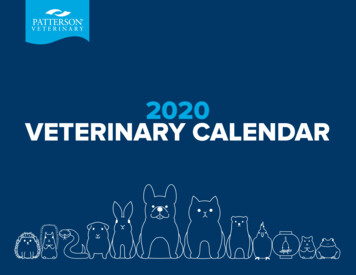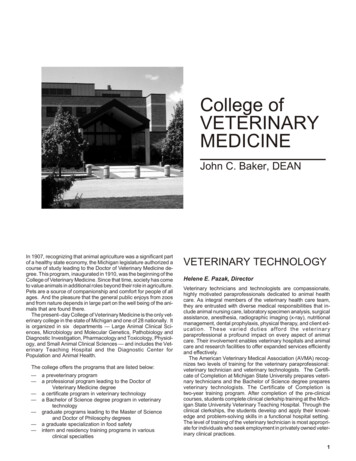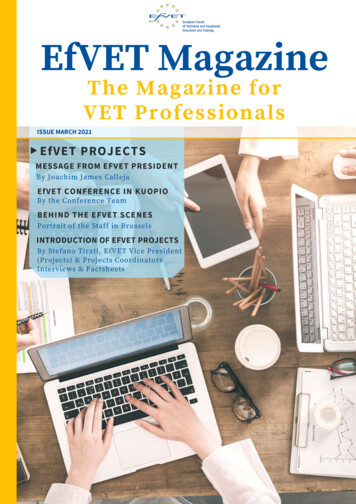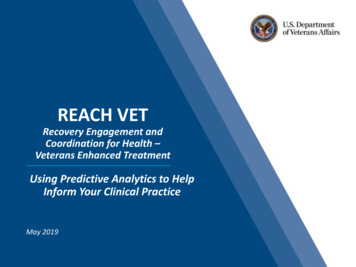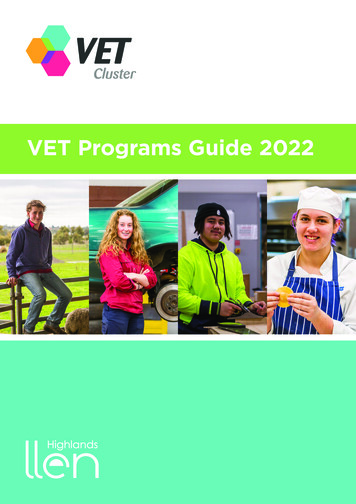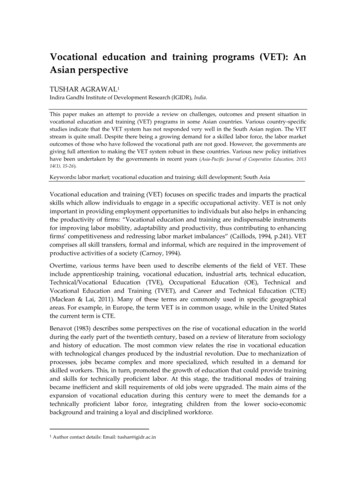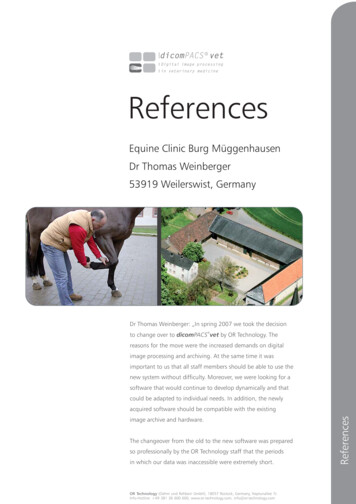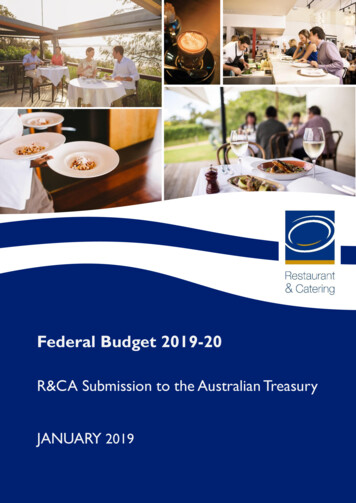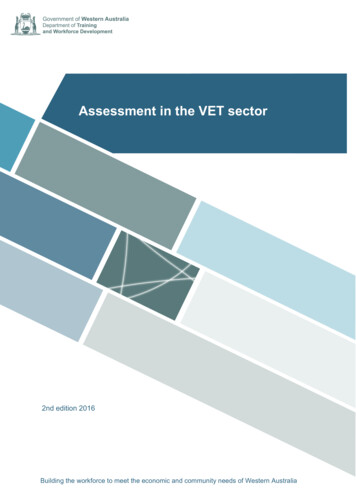
Transcription
Assessment in the VET sector2nd edition 2016Building the workforce to meet the economic and community needs of Western Australia
First published 20152nd edition 2016DISCLAIMERWhile every effort is made to maintain their accuracy, currency and usefulness, thesepublications are edited only once a year and may not remain current with changesimplemented at state and federal level. The publications are accurate as at the date ofpublication shown on this page. If in doubt, please check the many websites referencedwithin each publication.TITLE:Assessment in the VET sector Department of Training and Workforce Development, Western Australia, 2016Reproduction of this work in whole or part for educational purposes within an educationalinstitution and on the condition that it is not offered for sale is permitted by the Departmentof Training and Workforce Development.Department of Training and Workforce Development1 Prospect Place, WEST PERTH WA 6005E: pd.sector.capability@dtwd.wa.gov.auW: dtwd.wa.gov.au
Assessment in the VET sector
ContentsIntroduction. 5Chapter 1 – Developing strategies for learning and assessment. 7What is competency‑based assessment?. 9The principles of assessment. 11Chapter 2 – Designing assessment tools. 13Four steps to quality assessment tools. 13Chapter 3 – Clustering units for assessment. 43Why should units of competency be clustered?. 43Chapter 4 – Reasonable adjustment and inclusive practice. 59Introduction. 59Reasonable adjustment defined. 59The purpose of reasonable adjustment. 61The kinds of reasonable adjustment that can be made. 62Preparing to make reasonable adjustment. 69Chapter 5 – Recognition of prior learning. 75Introduction. 75RPL assessment processes. 75General principles for RPL. 77A task‑based model for RPL. 79Chapter 6 – Assessor competencies. 83Introduction. 83Is the demonstration of equivalence the same as RPL?. 84Industry currency. 84Chapter 7 – Validation and evaluation. 87Introduction. 87The purpose of an improvement process. 87Systematically collecting and analysing data. 88Demonstrating improvements. 89Aspects of assessment to be monitored. 89Quality standards in assessment. 91Stakeholders in quality assessment. 93Strategies for improvement. 93 VET (WA) Ministerial Corporation 20163
Assessment in the VET sectorRecording the outcomes of improvement activities. 96Gathering the evidence for continuous improvement. 97Government authorities. 102Regulatory authorities. 102Appendix 1 – Useful links and resources. 103Introduction. 103Websites providing ongoing information relevant to competency‑basedassessment. 103Other publications and resources. 104Organisations providing information or assistance on assessment. 105Appendix 2 – Glossary. 1074 VET (WA) Ministerial Corporation 2016
IntroductionThe purpose of this publication is to provide practitioners and other stakeholders inthe vocational education and training sector in Western Australia with informationon the processes and practices involved in an assessment system.This information has not been referenced to specific regulatory standards; however,it is based on current standards and reflects good practice. The informationapplies to training package qualifications and accredited courses with a vocationaloutcome.While the regulatory standards do not specify any particular documentation forassessment systems, the documents in this publication are examples that aregistered training organisation can consider and adopt as required.This publication consists of the following: an introduction to developing strategies for assessment and the conceptsaround competency‑based assessment; a guide to the development of assessment tools; information about how to cluster units of competency for assessment; a guide to planning and conducting assessment process for employers andassessors involved in competency‑based assessment; how to adjust assessment processes and tools for inclusive practice; a guide to conducting RPL; information about assessor competencies; a guide to validation and evaluation of assessment systems and processes; a list of resources for assessors, including websites, organisations and materialson assessment; and a glossary of terms.A series of exemplar materials and templates for adaptation and use bytrainers/assessors is provided throughout. VET (WA) Ministerial Corporation 20165
Assessment in the VET sectorChapter 1Developing strategies for learning and assessmentRegistered training organisations are tasked with developing learning andassessment strategies, processes and materials that meet the needs of their clientsand maximise outcomes. This can include learning and assessment that lead to theaward of a statement of attainment or a full qualification.In order to meet clients’ needs and maximise outcomes, RTOs need to developprocesses and products that focus on the quality of the learning and assessmentexperience. It is well established in research that effective strategies involvelearners: making sense of new knowledge and skills, and developing understandingrather than simply learning sets of facts and information to be reproduced whenrequired; looking for what is significant, such as key concepts and principles, relationshipsbetween ideas, and lines of reasoning; relating new ideas to previous knowledge and experiences; finding the link between conceptual knowledge and real‑world applications; and employing higher order thinking skills through examining issues, clarifyingproblems, producing their own ideas and thinking critically.The learning and assessment strategy provides a clear picture of the learning andassessment delivered to the learner and how and when this will be achieved. It isthe blueprint for the delivery of the qualification or skill set. To be able to develop aneffective strategy, the RTO needs to consult and consider the following informationwhen developing a learning and assessment strategy.A training package is endorsed by the Skills Service Organisation or its delegate inaccordance with the Standards for Training Packages. The endorsed componentsof a training package are: units of competency; assessment requirements (associated with each unit of competency); qualifications; and credit arrangements.The endorsed components form part of the requirements that an RTO must meetunder these Standards. A training package also consists of a non‑endorsed,quality‑assured companion volume which contains industry advice to RTOs ondifferent aspects of implementation. The companion volumes can be found on theSSO websites.6 VET (WA) Ministerial Corporation 2016
Training package qualifications are designed to allow customisation to meet theneeds of a range of learners. This is achieved by choosing a combination of unitsof competency that meet the needs of both the learner and the industry, as wellas the packaging rules for the qualification. The RTO will consult with industry andpotential learners to discuss and decide which units to include in the qualification.The following factors may influence the choice of units: the type of work undertaken in the workplace; the availability of machinery/equipment and staff to support the learning andassessment; any conditions imposed by licensing authorities or regulatory requirements; any competency already held by the learner; and any seasonal or shift requirements that may restrict the opportunity for learningand assessment.This list is not definitive and the RTO’s discussions with industry and the learnerwill uncover other opportunities or restrictions that may need to be consideredin deciding the qualification packaging. RTOs need to be aware of any deliveryrequirements specified in legislation or regulations. Any concerns that an RTO mayhave in this regard should be discussed with the appropriate governing body.Once a decision has been made about the units of competency to be included inthe qualification, the delivery and assessment schedule and methodologies can bedetermined. The following factors will influence these decisions: any prerequisites stipulated by the training package; the most logical order for delivery and assessment of the units of competency(or clusters of units); the integration of on the job and off the job training (if appropriate); the qualifications and experience of the staff delivering or supporting learningand conducting assessment; the accessibility and availability of any resources needed, including equipment,machinery and supervisory staff; the requirement for simulation (if any); the arrangements for access to workplaces (if required); the most appropriate methodology for delivery and assessment, both on andoff the job, subject to legislation or regulations which may include nationalrecognition or recognition of prior learning; any special arrangements for trainingand/or assessment that need to be made for learners with special needs; and the expected duration of the qualification, including determining the amount oftraining the learners require. VET (WA) Ministerial Corporation 20167
Assessment in the VET sectorDecisions relating to these factors should be recorded in the strategy, or thestrategy should refer the reader to this information if it is recorded in othersupporting documents. Learners also need information about the support andadministrative services offered by the RTO. This information is normally providedbefore a learner enrols and may influence the learner’s decision to engage withthe RTO. For example, if the learner needs numeracy support and the RTO doesnot have the capacity to provide that support, alternative arrangements wouldneed to be made or the learner may choose to use another RTO that can providethe support. Administrative information such as fees, refunds, accessing RTOresources, and complaints and appeals must also be provided at this time.What is competency‑based assessment?Competency‑based assessment is the process of collecting evidence and makingjudgements on whether an individual has achieved competence. This confirmsthat an individual can perform to the standard expected in the workplace asexpressed in the nationally endorsed competency standards (where they exist), oncompetency standards developed by relevant industry, enterprise, community orprofessional groups, or on outcomes of accredited courses, if there are no relevantnationally endorsed competency standards.How do you know if an individual is competent?You know whether an individual is competent after they have completed anassessment that verifies that all aspects of the unit of competency are held andcan be applied in an industry context. Just as learner drivers must demonstratethat they can drive a car by taking the examiner for a drive, so too must learnersdemonstrate competence by undergoing an assessment process. Assessment mayinvolve a variety of methods.Individuals can be assessed during their training, at the end of their training, orwithout undertaking any training – for example, if they believe that they are alreadycompetent. Those being assessed are often called ‘candidates’. The method andtiming of assessment will vary depending upon the assessor, the candidate and thecompetency being assessed.Against which standards are learners assessed?Learners are judged against competency standards (often called units ofcompetency) developed by industry to assess whether they are competent.A competency standard comprises individual units of competency that include theessential information needed to assess a learner.8 VET (WA) Ministerial Corporation 2016
Chapter 1 – Developing strategies for learning and assessmentSome enterprises have developed specific competency standards for theirbusinesses and, in some cases, these have been nationally endorsed in enterprisetraining packages or used in state accredited courses.To gain a formal qualification, for example, a Certificate II or a diploma, individualshave to be competent in a specified group of units of competency. Informationon the qualifications and relevant units of competency are outlined in accreditedcourses or training packages.What sort of evidence is collected?Evidence collected may be: direct – such as observation of workplace performance; indirect – such as formal testing; or supplementary – such as references from employers.Evidence is used by an assessor to make a judgement about whether a learneris competent. It is the responsibility of the assessor to determine what and howmuch evidence is required to make the assessment judgement. Training packagesprovide guidance on the types of evidence required, and further advice may begained through comparing, and industry consultation.What is an assessment tool?Assessment tools – also called evidence‑gathering tools – contain both theinstrument and the instructions for gathering and interpreting evidence in anassessment process. They form part of the bank of resources used for effectiveand safe assessment practice in a sector where assessment is conducted withina quality assurance framework.An assessment tool is made up of the following components: the context and conditions for the assessment; the tasks to be administered to the learner; an outline of the evidence to be gathered from the learner; the evidence criteria used to judge the quality of performance, for example,the decision‑making rules; and the administration, recording and reporting requirements.The tasks to be administered to the learner, the outline of the evidence to begathered from the learner and the evidence criteria used to judge the quality ofperformance are often referred to as the assessment instrument. VET (WA) Ministerial Corporation 20169
Assessment in the VET sectorThe principles of assessmentWhen developing assessment tools and conducting assessment, trainers/assessorsneed to ensure that the principles of assessment are met. This is not only goodpractice but also a requirement of the regulatory standards. The principles ofassessment require that assessment is valid, reliable, flexible and fair.ValidAny assessment decision of the RTO is justified, based on the evidenceof performance of the individual learner.Validity requires that: assessment against the unit(s) of competency and the associatedassessment requirements covers the broad range of skills andknowledge essential to competent performance; assessment of knowledge and skills is integrated with their practicalapplication; assessment is to be based on evidence that shows that a learner candemonstrate these skills and knowledge in other similar situations;and judgement of competence is based on evidence of learnerperformance that is aligned to the unit(s) of competency andassociated assessment requirements.ReliableEvidence presented for assessment is consistently interpreted andassessment results are comparable, irrespective of the assessorconducting the assessment.FlexibleAssessment is flexible to the individual learner by: reflecting the learner’s needs; assessing competencies held by the learner, no matter how or wherethey have been acquired; and drawing from a range of assessment methods and using those thatare appropriate to the context, the unit of competency and associatedassessment requirements, and the individual.FairThe individual learner’s needs are considered in the assessmentprocess.Where appropriate, reasonable adjustments are applied by the RTO totake into account the individual learner’s needs.The RTO informs the learner about the assessment process andprovides them with the opportunity to challenge the result of theassessment and be reassessed if necessary.10 VET (WA) Ministerial Corporation 2016
Chapter 1 – Developing strategies for learning and assessmentThe rules of evidenceWell‑designed assessment tools will help to ensure that the evidence collected is:ValidThe assessor is assured that the learner has the skills, knowledge andattributes described in the module or unit of competency and associatedassessment requirements.SufficientThe assessor is assured that the quality, quantity and relevance of theassessment evidence enable a judgement to be made of the learner’scompetency.AuthenticThe assessor is assured that the evidence presented for assessment isthe learner’s own work.CurrentThe assessor is assured that the assessment evidence demonstratescurrent competency. This requires the assessment evidence to be fromthe present or the very recent past. VET (WA) Ministerial Corporation 201611
Assessment in the VET sectorChapter 2Designing assessment toolsFour steps to quality assessment toolsAs with the design of all products, the quality of an assessment tool will dependon the time and effort that go into the research and development phases of itsconstruction, and the ongoing testing and refining of prototypes.There are four steps in the design process. Step 1 – Familiarising yourself with the mandatory requirements of theassessment task(s); Step 2 – Using your understanding of the specified competencies to chooseappropriate assessment method(s); Step 3 – Getting down to business and devising the assessment tool(s); and Step 4 – Trialling and refining your tools to help you maximise confidence thatthe tool(s) can be used flexibly and help you to make valid, reliable and fairjudgements.The following four‑step process will help you to design assessment tools thatproduce quality outcomes.Step 1 –Clarify the evidence requirements.Step 2 –Choose your assessment methods.ActStep 3 –Design and develop your assessment tools.ReflectStep 4 –Trial, refine and review your tools.Plan12 VET (WA) Ministerial Corporation 2016
Step 1 – Clarify the evidence requirementsPicturing competenceMany guides for trainers/assessors recommend that you start by testing your ownunderstanding of the requirements of the units of competency by visualising acompetent person at work.When you are clear about the tasks that such a person will perform and manage,the contingencies that might arise, and in what contexts they are likely to applytheir skills, you are ready to design a training program and select an appropriateassessment methodology.Your picture may be recorded as a competency profile, written in accessiblelanguage that is familiar to a learner and/or workplace as in the following example.Competency profile for the unit MSL922001 Record and present dataThe activity is recording and presenting data in testing of constructionmaterials.A laboratory assistant is given 20 soil samples and asked to test their moisturecontent by weighing each sample, placing them in an oven for 24 hours andthen reweighing them. The assistant performs the tests in accordance withthe standard method and then calculates the percentage of water content bydividing the weight loss by the wet weight and multiplying by 100.The assistant checks the results and notices that they are consistently lessthan previous results recorded for soils at the same site. The assistantidentifies the discrepancy and confirms that the oven operated at the requiredtemperature, but also notes that the previous computer calculation of themoisture content divided the weight loss by the wet weight instead of the dryweight. The assistant recognises this and so recalculates the moisture contentfor the 20 samples and notes that the results are now consistent with previousresults of other samples and is accurate. The assistant then enters the correctresults into the laboratory information management system.Once you have developed your competency profile and examined the sum total ofthe activities undertaken by a person doing that job, you will be in a better positionto identify opportunities to cluster units of competency to reflect actual workplacepractices.Examining the benchmarksTo decide whether a person is competent, you need a set of criteria or benchmarksagainst which to assess their competencies. In the VET sector, nationalcompetency standards – the smallest of which is a unit of competency – are the VET (WA) Ministerial Corporation 201613
Assessment in the VET sectorusual benchmarks against which a learner is assessed. Other benchmarks mightinclude assessment criteria or evidence requirements from accredited courses,the requirements of international or Australian standards, and organisationalbenchmarks such as operating procedures, WHS standards and productspecifications.The following diagram broadly illustrates the relationship between: benchmarks; evidence requirements; assessment methods and tools; and the evidence produced.Figure 1: From benchmark to evidence collectionBenchmarks determine evidence ering)toolsEvidenceproducedBenchmarksare thestandardsagainst whicha learner isassessed.This is theinformationwhich, whenmatchedagainst thebenchmarks,shows thata learner iscompetent.These are thetechniquesused to gatherdifferent typesof evidence.These areinstrumentsandinstructions forgathering andinterpretingevidence.This is theinformationon which theassessmentjudgement ismade.ExampleExampleExampleExampleExampleSell productsto customers.What islearner’sproductknowledge?Real sessmentThird‑partyreportDemonstrationof uctions forlearners andlecturersDemonstrationof customerservice andselling skillsEvidence aligned to benchmark14 VET (WA) Ministerial Corporation 2016
Chapter 2 – Designing assessment toolsConfirming the evidence requirementsEvidence is the information that, when considered against a unit of competency,enables you to confidently judge whether or not a person is competent. Unlikeother forms of assessment, competency‑based assessment does not involvecomparisons between learners. Learners are assessed against standards whichare clearly defined and articulated.In order to decide what evidence you need to collect, you must be absolutely sureof the competency requirements by examining a number of sources of essentialinformation including: the elements of the unit(s) of competency, the performance criteria, thefoundation skills, the performance evidence and knowledge evidence, and theassessment context information; the dimensions of competency – the task, task management, contingencymanagement and job/role environment skills; the employability skills, if relevant; the relevant Australian Qualifications Framework descriptor; and related workplace processes, procedures and systems that help you tocontextualise the activity you are required to assess. Be sure to include anylegislative, WHS or legal requirements that may need to be considered whenconducting assessment.Once you have examined/revisited the available information sources, and consultedwith relevant industry or workplace personnel, you should be in a position to list theevidence requirements using the following simple table.Table 1: Evidence requirements (checklist)Unit of competencyEvidence needed: VET (WA) Ministerial Corporation 2016As specified in/by:15
Assessment in the VET sectorUnderstanding what evidence is required for each unit is essential for the RTO tomake valid judgements for each unit, but also to determine whether there is anopportunity to cluster units and use common evidence for assessment decisions.Chapter 3 discusses clustering in detail.Identifying your learnersThe learners your assessment methods and tools need to cater for might bebroadly based or come from a clearly defined target group, such as an enterpriseor an industry sector. They may be employees with a particular job profile or agroup defined by funding body requirements. Where possible, it is important thatyou identify your learner group in order to design appropriate tools that meet theirneeds.SummaryBeing absolutely clear about the standards or criteria against which you areassessing, the evidence requirements, and, where possible, the characteristicsof your learners, are essential requirements of the design process. The time youspend deciding what evidence is required will pay dividends when you design yourlearning program and your assessment plan and tools.Step 2 – Choose your assessment methodsWhen choosing the assessment methods, you are going to use for particular unit(s)of competency, you need to refer to the specific unit(s) of competency and usethem as a guide. With your profile of a competent worker in mind and knowingwhat knowledge and skills you require your learners to demonstrate, you are nowin a position to determine which methods you will use to gather that evidencein collaboration with learners as well as colleagues/trainers/assessors andindustry/enterprise representatives.Real work does not usually fall into categories that reflect individual units ofcompetency. In general, a real work activity draws on a number of units ofcompetency at the one time.A good assessment task may involve clustering a number of competencies toreflect a real work task or particular job role. The degree to which a number of unitscan be clustered together to reflect a real work activity will vary across all trainingpackages. Training packages can contain skill sets identifying groups of units ofcompetency that meet specific work roles or regulated/licensed activities which maybe clustered for good practice assessment.Clustering should take account of the work activity, the assessment context,the training and assessment arrangements for the qualification, and the time,resources, facility and personnel available. Trainers/assessors are required tohave a thorough knowledge of the training package they are working with and therelevant workplace environment.16 VET (WA) Ministerial Corporation 2016
Chapter 2 – Designing assessment toolsAppropriate clustering is a key way to ensure that assessments are holistic in thatthe assessor can gather evidence and cross‑reference it across a number of unitsof competency. Clustering, where appropriate, may also result in reducing the timeand cost of assessment.How will you gather the evidence?Selecting an appropriate assessment/evidence‑gathering method is part of thefun and challenge of professional practice. It usually involves weighing up a rangeof assessment methods in order to decide upon ‘best fit’ techniques, which mayinclude those in the following table.Table 2: Assessment methodsMethodsExamples of methodsDirect observation Real work/real‑time activities at theworkplace Work activities in a simulated workplaceStructured assessment activities Simulation y sheetsQuestioning Written questionsInterviewsSelf‑evaluationVerbal questioningQuestionnairesOral or written examinations (may beapplicable at higher AQF levels)Evidence compiled by the learner PortfoliosCollections of work samplesProducts with supporting documentationHistorical evidenceJournals/logbooksInformation about life experienceReview of products Products as a result of a project Work samples/products VET (WA) Min
a guide to the development of assessment tools; information about how to cluster units of competency for assessment; a guide to planning and conducting assessment process for employers and assessors involved in competency‑based assessment; how to adjust assessment processes and tools for inclusive practice;


